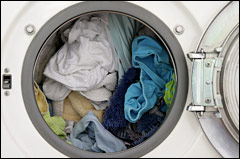If you think of your home as a haven from pollution, we’ve got some bummer news. Levels of pollutants in indoor air can be from two to more than 100 times higher than outdoors, according to the U.S. EPA. That indoor pollution is due in large part to volatile organic compounds (VOCs) that evaporate, or “offgas,” from home decorating and cleaning products.

Make your home clean and green.
Photo: iStockphoto
So if the weather cooperates, step one for green cleaners is: Open a window and let those pollutants out! Yet even in the spring and summer, when a vase of daffodils can fill a room with a lovely natural scent, many consumers stubbornly keep using synthetic room fresheners and fragranced cleaning products that are full of VOCs and other toxic chemicals. These can make our indoor air unhealthy, provoke skin, eye, and respiratory reactions, and harm the natural environment.
Take those so-called air fresheners. According to a study published in New Scientist in 1999, in homes where aerosol sprays and air fresheners were used frequently, mothers experienced 25 percent more headaches and were 19 percent more likely to suffer from depression, and infants under six months of age had 30 percent more ear infections and 22 percent higher incidence of diarrhea.
In choosing alternatives, however, consumers need to be alert to greenwashing. “Just because a product says it’s natural doesn’t mean it’s nontoxic,” says Jeffrey Hollender, CEO of Seventh Generation, which produces genuinely eco-friendly cleaning supplies and household products. The word “natural” is undefined and unregulated by the government and can be applied to just about anything under the sun — including plastic, which comes from naturally occurring petroleum. Because no standards exist, claims such as “nontoxic,” “eco-safe,” and “environmentally friendly” are also meaningless, according to Consumers Reports’ Eco-labels website.
Instead of being taken in by slogans, David Steinman, coauthor of The Safe Shopper’s Bible, advises looking at labels for specific, eco-friendly ingredients that also perform effectively. These include grain alcohol instead of toxic butyl cellosolve as a solvent; coconut or other plant oils rather than petroleum in detergents; and plant-oil disinfectants such as eucalyptus, rosemary, or sage, rather than triclosan. You can also mix your own cleaners, as does Annie Berthold-Bond, green living editor at Care2.com and author of Clean and Green and Better Basics for the Home. According to Berthold-Bond, a few safe, simple ingredients such as plain soap, water, baking soda (sodium bicarbonate), vinegar, washing soda (sodium carbonate), lemon juice, and borax can satisfy most household cleaning needs — and save you money at the same time.
If you’re in the mood to detoxify, getting rid of germs doesn’t have to mean overkill: This is your home, not a hospital. In 2000, cleaning products were responsible for nearly 10 percent of all toxic exposures reported to the U.S. poison control centers, accounting for more than 206,000 calls, over half of which concerned children under the age of six. According to Philip Dickey of the Washington Toxics Coalition, the most acutely or immediately hazardous cleaning products are corrosive drain cleaners, oven cleaners, acidic toilet-bowl cleaners, and anything containing chlorine or ammonia (which should never be combined — see below).
Read on to get the dirt on various conventional products and ingredients and their eco-friendly alternatives. With a little effort, you can make your home a truly clean haven rather than a chemical storage tank.
Dish Detergents, Laundry Detergents, and All-Purpose Cleaners

It’s a wash.
Photo: iStockphoto
Problems:
Most conventional dish and laundry detergents are made from petroleum, a nonrenewable resource. Some detergents contain alkyphenol ethoxylates, which are suspected hormone disruptors that don’t readily biodegrade and can threaten wildlife after they go down your drain. Ethoxylated alcohols in liquid detergents can contain carcinogenic 1,4-dioxane.
The fragrances in detergents and fabric softeners can contain phthalates, chemicals that have been linked to cancer and reproductive-system harm in animal lab tests. Fragrances may also trigger asthma and allergic reactions, with symptoms including skin and respiratory irritation, headaches, and watery eyes. Although phosphates, which choke waterways, are no longer used in most dish and laundry soaps, they can be found in dishwasher detergents. Phosphates are highly caustic and can be fatal if swallowed.
Other ingredients turn dangerous when combined: Diethanolamine and triethanolamine can react with nitrites (an often undisclosed preservative) to form carcinogenic nitrosamines.
Solutions:
Use laundry soaps labeled “fragrance-free,” advises Harvey Karp, a Los Angeles pediatrician and author of The Happiest Baby on the Block. If you want to use citrus-oil products, sniff-test a small amount from a few feet away, as these products can be irritating to allergic or sensitive individuals. Karp also advises choosing dish and laundry detergents and all-purpose cleaners that are plant-based (corn, palm kernel, or coconut oil).
To remove stains from clothing, try soaking fabrics in water mixed with borax, lemon juice, hydrogen peroxide, washing soda, or white vinegar. Or, look for “non-chlorine bleach” made from sodium percarbonate or sodium perborate, available from Bio Pac, Ecover, Naturally Yours, Shaklee, or Seventh Generation.
Fabric can be softened by adding one-quarter cup of baking soda to the wash cycle; this recently worked on several pairs of catalog-bought cargo pants made of a cardboard-stiff cotton that literally scraped a teenager’s skin. A quarter cup of white vinegar will also soften fabric, as well as eliminate cling.
Less toxic products include Ecover and Seventh Generation laundry and dish soaps; Aubrey Organics and Vermont Soapworks all-purpose household cleaners; and Bioshield and Naturally Yours dishwasher detergent.
Antibacterial Soaps and Cleansers, Bleach, Stain Removers, Disinfectants, Glass Cleaners, and Bathroom Scouring Powders (Whew!)
Problems
Popular in liquid form, antibacterial soaps are helping to promote growth of resistant bacteria, according to a 2000 World Health Organization report.
Chlorine bleach, a common disinfectant frequently found in scouring powders and cleaning solutions, is highly caustic, meaning it can burn skin and eyes — plus it can be fatal if swallowed. When it travels from your drain into the natural world, it can create organochlorines, which are suspected carcinogens as well as reproductive, neurological, and immune-system toxins. And be warned: Bleach (also known as sodium hypochlorite and sodium hydroxide) should never be mixed with any product containing ammonia or quaternium compounds. Doing so creates highly toxic chlorine gas. Many conventional scouring powders and cleaning solutions contain chlorine bleach.
Solutions
Instead of using antibacterial soap, Karp recommends thorough hand-washing (about two minutes’ worth) with plain soap and warm water.
To disinfect bathroom or kitchen surfaces, try Earth Power‘s EPA-registered herbal disinfectant or Seventh Generation sanitizers. White vinegar helps kill bacteria, mold, and viruses, according to Berthold-Bond, who uses it on everything from kitchen surfaces to toilet seats. However, the only foolproof way to kill food-borne pathogens such as salmonella or E coli is to use hot, soapy water to wash all cutting boards, dishes, knives, and surfaces that have touched raw meat or eggs.

Oops, you missed a spot!
Photo: iStockphoto
Scrubbing sinks, tubs, and countertops with a paste of baking soda and water effectively removes dirt rings and some stains; if that doesn’t work, try a paste of washing soda and water, and be sure to wear gloves. Commercial non-chlorine bleach products include Bon Ami scouring powder and cream cleansers from Earth Friendly, Ecover, and Seventh Generation.
For cleaning windows, fill your own spray bottle with water and either one-quarter cup white vinegar or one tablespoon lemon juice to cut grease. Safer commercial glass cleaners are made by BioShield, Earth Friendly, Naturally Yours, and Seventh Generation.
Drain, Oven, and Toilet-Bowl Cleaners
Problems
The corrosive ingredients in these products can severely irritate eyes, skin, and the respiratory tract, and can be fatal if swallowed. Chemical drain cleaners are among the most dangerous of all cleaning products, containing sodium hydroxide and sodium hypochlorite (bleach) that can permanently burn eyes and skin. In oven cleaners, lye and sodium hydroxide can burn skin, eyes, and the respiratory tract.
Solutions
For drains, a plunger “snake” plumbing tool should first be used to bring up as much of the clog as possible, giving cleaning products room to work, or perhaps eliminating the need for them entirely. Earth Friendly and Naturally Yours drain cleaners use enzymes, rather than caustic chemicals, to dissolve obstructions. Don’t forget to prevent future blockage with inexpensive metal or plastic drain screens, available at most home-improvement or hardware stores.
To clean oven surfaces, coat them in a paste of water and baking or washing soda and let stand overnight, then scrub off the paste while wearing gloves. Among commercial products, EnviroSafety‘s plant-based multi-purpose cleaner works well. Or you can use the non-chlorine scouring powders and creams listed above. To prevent future buildup, line the oven floor with aluminum foil and wipe oven walls and ceiling clean after each use.
For toilets, forget the fancy stuff: Again, use the simple, non-chlorine scouring powders and creams listed above, or try AFM SafeChoice or Ecover toilet cleaners.
Furniture and Metal Polishes
Problems
These are corrosive and may cause eye, skin, or respiratory tract irritation. They can also contain nerve-damaging petroleum distillates or formaldehyde, a carcinogen.
Solutions
Polish furniture with a mixture of one teaspoon olive oil and one-half cup white vinegar, or look for solvent-free products that use mineral or plant oils, such as Earth Friendly furniture polish or Hope’s lemon oil.
As your grandmother probably knows, silver can be kept clean with toothpaste. Copper can be polished using a cloth dipped in white vinegar or lemon juice with salt dissolved in it; just rinse with water when you’re done. You can shine your brass with a paste made from one teaspoon salt, one cup white vinegar, and one cup flour. Or, use Kleen King copper and stainless steel cleaner, Twinkle copper and silver polishes, or Hope‘s brass and silver polishes.
Air Fresheners and Other Perfumed Products
Problems
Aerosol propellants contain flammable and nerve-damaging ingredients as well as tiny particles that can lodge in your lungs. Fragrances of all kinds can provoke allergic and asthmatic reactions.
Solutions
If the air outside is clean, open your windows and ventilate the natural way. An open box of baking soda removes odors. (If you’re feeling Martha Stewart-ish, you can decant it from the box into a pretty bowl.) Cedar blocks or sachets of dried flowers and herbs provide gentle scents — but avoid any potpourri that lists unspecified “fragrance” on the label; this could mean synthetic chemicals, including phthalates. Look for products scented with essential plant oils, such as lemon, verbena, or lavender.
Finally, we cannot stress enough that you should avoid aerosol sprays in any product, as they disperse ingredients through the air and make them easy to inhale. Even nontoxic ingredients can irritate eyes, noses, and lungs. Carelessly shaken powders can also spread through the air and cause irritation.
Now Get to It!
Most of the eco-friendly products mentioned above can be found in supermarkets or natural-food, hardware, and home-improvement stores — or online. For more complete info and further tips, see the Green Guide website, and check out the green-cleaning advice in Grist’s book, Wake Up and Smell the Planet.
And remember: When it comes to green cleaning, less is definitely more!


